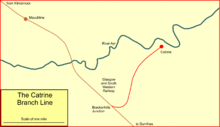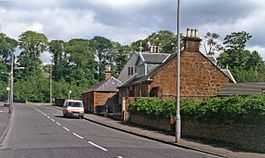Catrine railway station
| Catrine | |
|---|---|
|
Location of the former station | |
| Location | |
| Place | Catrine |
| Area | East Ayrshire |
| Operations | |
| Pre-grouping | Glasgow and South Western Railway |
| History | |
| 1 September 1903 | Opened |
| 3 May 1943 | Closed |
| Disused railway stations in the United Kingdom | |
|
Closed railway stations in Britain A B C D–F G H–J K–L M–O P–R S T–V W–Z | |
| UK Railways portal | |
Catrine railway station was a railway station serving the village of Catrine in East Ayrshire, Scotland.
The station was the only station the Catrine branch line, part of the Glasgow and South Western Railway (G&SWR), open to passengers from 1903 to 1943.
History

Catrine is located on the River Ayr; the small town had cotton mills that had been founded by the social reformers Claud Alexander and David Dale.[1]
It was about two miles (3 km) from the main line of the Glasgow and South Western Railway (G&SWR) when the line was opened between Glasgow and Carlisle in 1850.[note 1] Even during construction of the main line, consideration had been given to building a branch to Catrine,[2] but the idea was not pursued.
Increasingly in the following decades, the disadvantage of not having a direct railway connection was felt, and a number of attempts were made to raise finance for a line, without success. In 1894, representatives of the community sent a petition to the Directors of the G&SWR asking them to fund a branch line; the population was 2,458, and would be greatly benefited by a railway connection. Moreover "Catrine has become a popular Holiday Resort, and would, during the Summer months ... have a considerable additional resident population, were Railway facilities afforded."[3]
In 1898 the G&SWR presented a Parliamentary Bill for fifteen new railways; the Company was in expansive mood. A Catrine Branch was one of the lines, and in fact the only one of the fifteen actually built.[4] The Bill received the Royal Assent on 29 August 1898.[note 2]
Construction proceeded, and the short branch line from Brackenhill Junction was opened on 1 September 1903.[1][4][5]
The passenger train service was typically four return journeys Mondays to Fridays, with six on Saturdays.[6] The service was operated by a newly built steam railcar.[4]
The railcar was more usually referred to as a railmotor, a passenger coach incorporating a small integral steam locomotive, designed by James Manson. The branch was operated by this type until the suspension of services during the First World War. Smith gives a flavour of the operation: drivers who were unable to continue on the most demanding jobs were allocated to the railmotor work:
As a nice, quiet, easy job, they were given the Catrine Caur—the Manson steam railmotor which worked the Mauchline - Catrine service. It broke their hearts. The cab was horribly draughty, and an overspill from the tank filler-hole kept the footplate perpetually wet. Jock Clark gave it up and returned to a humble labouring job at Ayr sheds. Cowan, I believe, caught a chill which was the cause of his death.
But plenty of the younger Ayr drivers—Willie Mackie, Jonnie McGarva, "Brigham" Young, Bob Duncan—did their bit on the Catrine Caur and seemed to knock quite a bit of fun out of the job. Game little thing she was, and a grand steamer. You could kindle her in the morning at Ayr with a barrowful of coal, dump another barrowful on the footplate, and away you went, 6 a.m. "workers" to Annbank, and then on to Mauchline to begin the day's shuttle service to Catrine. On the first run out of Catrine in the morning you would bring a bogie compo. and a milk-van with you—and the grade out of Catrine is 1 in 60 for over a mile. One day Duncan ran her over the 3.4 miles from Mauchline to Catrine in 5 minutes.[7]
The railmotor is depicted in a photograph in Smith's Tales, before page 25.[7]
The branch closed to passengers as a wartime economy measure on 1 January 1917, but reopened in January or February 1919. It closed to passengers permanently on 3 May 1943,[8][9] and goods traffic was discontinued from July 1964.[6]
The Royal Train
David L Smith recounts a difficulty when the Royal Train was stabled on the branch:
On 3 June 1942, King George VI and Queen Elizabeth paid a visit to Scotland, travelling during the night. They had a train of 440 tons, and hauled by two Kingmoor compounds, nos. 1141 and 1145. They passed New Cumnock around 3 a.m., and some genius arranged to put them down the Catrine branch for the remainder of the night. A Caley class 3F 0-6-0 was put at the rear end to supply steam heat. At a suitable hour of morning they set off again. Now the Catrine branch consisted of 1¼ miles of 1 in 60 right up to the junction, with a final sharp curve. The rail was probably wet, the compounds slipped furiously, and they came to a dead stand three times. Finally they had to get the steam heat engine up to push in the rear. They got to Kilmarnock, and there discovered that in the struggles no. 1141 had broken a spring hanger.[10]
References
- ↑ 1.0 1.1 Campbell Highet, The Glasgow & South-Western Railway, Oakwood Press, Lingfield, 1965
- ↑ The Railway Magazine (periodical), Volume 52, 1923, page 54
- ↑ Petition from meeting of 30 April 1894, reproduced in Ross, page 146
- ↑ 4.0 4.1 4.2 David Ross, The Glasgow and South Western Railway: A History, Stenlake Publishing Limited, Catrine, 2104, ISBN 978 1 84033 648 1
- ↑ Stephenson Locomotive Society, The Glasgow and South Western Railway 1850 - 1923, published by the Stephenson Locomotive Society, London, 1950
- ↑ 6.0 6.1 Gordon Stansfield, Ayrshire and Renfrewshire's Lost Railways, Stenlake Publishing Limited, Catrine, 1999, ISBN 1 84033 077 5
- ↑ 7.0 7.1 David L Smith, Tales of the Glasgow and South Western Railway, Ian Allan Limited, Shepperton
- ↑ M E Quick, Railway Passenger Stations in England Scotland and Wales—A Chronology, The Railway and Canal Historical Society, 2002
- ↑ Butt 1995, p. 56.
- ↑ David L Smith, Legends of the Glasgow and South Western in LMS Days, David and Charles (Publishers) Limited, Newton Abbot, 1980, ISBN 0 7153 7981 X
Notes
- ↑ The line here was built by the Glasgow, Paisley, Kilmarnock and Ayr Railway but immediately on opening it was vested in the G&SWR.
- ↑ From Ross, page 145. It is ambiguous whether he means 1898 or 1899.
Sources
- Butt, R. V. J. (1995). The Directory of Railway Stations: details every public and private passenger station, halt, platform and stopping place, past and present (1st ed.). Sparkford: Patrick Stephens Ltd. ISBN 1-8526-0508-1. OCLC 60251199.
| Preceding station | Disused railways | Following station | ||
|---|---|---|---|---|
| Terminus | Glasgow and South Western Railway Catrine Branch |
Mauchline Line and station closed | ||
